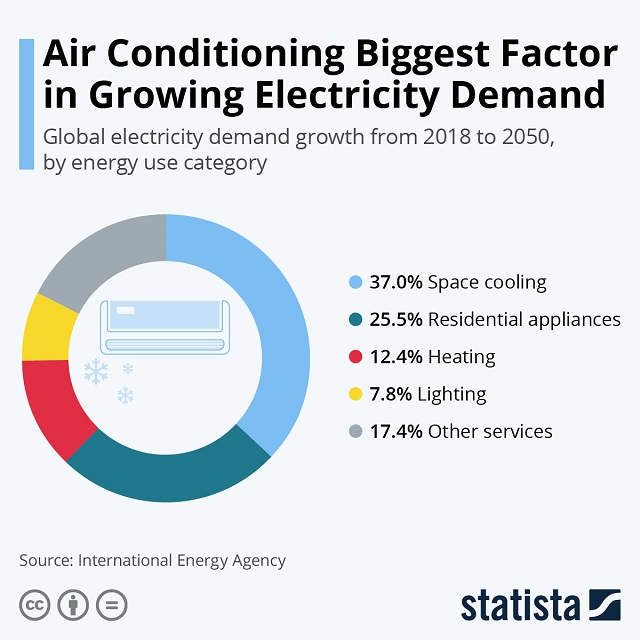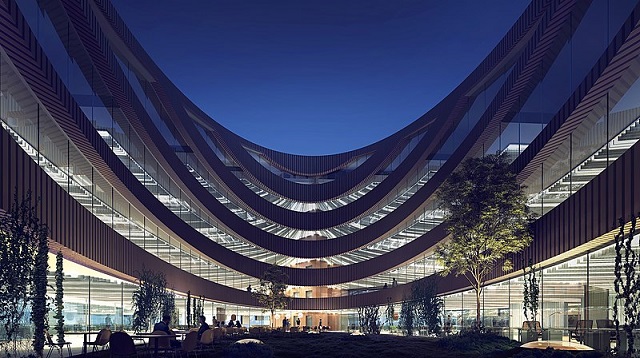
Decarbonization of the world's buildings is critical to meeting global climate goals. Photo by Fabio Achilli/Flickr
Reducing carbon emissions in buildings will be critical to achieving the Paris climate goals and achieving net zero emissions by 2050. Buildings represent 39% of global greenhouse gas emissions, including 28% in operational emissions and 11% in building materials and construction.
Global building floorspace is projected to double by 2060 and only 3% of investment in new construction is green and efficient, locking in high emissions for decades. The renovation rate for existing buildings is barely 1%, less than a third of the rate needed to meet the Paris climate goals.
While the decarbonization challenges for buildings are significant, so are the opportunities. Efficient, zero carbon buildings take advantage of available, cost-effective technology to reduce emissions while increasing health, equity and economic prosperity in local communities.
There are four crucial trends driving zero carbon buildings: decarbonization, electrification, efficiency and digitalization. These four good “DEEDS” work in combination to reduce the carbon emissions and overall cost of building operations and supporting infrastructure. Buildings can achieve zero carbon (or zero carbon ready) performance by eliminating fossil fuel use for heating, using on-site and/or off-site renewable energy, reducing the use of high global warming potential refrigerants and using low-carbon, reused or recycled materials in construction.

Global warming will itself result in more electricity demand as previously moderate regions, as recently occurred in the U.S. Pacific Northwest, require air conditioning to minimize heat stress. Unseasonably cold weather can also increase electricity demand in warmer regions. This will, in some cases, result in higher costs for building owners due to the lower (often subsidized) cost of fossil energy and increased electricity infrastructure investment for expanded generation, transmission, distribution and management of an increasingly intermittent renewable energy supply.
Energy efficiency must remain a top priority for zero carbon buildings, even with a decarbonized energy supply. Every dollar invested in energy efficiency saves about two dollars in energy supply, whether that investment is made in local, on-site generation or at a grid level. It also reduces the total cost of future grid infrastructure to meet increased demand. While passive measures, such as increased insulation and higher efficiency equipment, can reduce overall electrical demand, active efficiency measures including automated demand response and dynamic energy optimization can provide demand flexibility to match intermittent renewable generation.
Digitalization is an important enabler of energy efficiency and demand flexibility in buildings. These “smart” buildings benefit from advanced sensing and controls, systems integration, data analytics and energy optimization to actively reduce energy use and demand while also improving occupant comfort, health, productivity and facility resilience. Embedding these digital capabilities in “smart” equipment and appliances can provide additional benefits including improved reliability and remote management in addition to energy and emissions reductions.
The potential energy savings from smart buildings is significant. Basic automated building controls can save 10-15% of energy in commercial buildings. More advanced functionality, such as demand-controlled ventilation, can save an additional 5-10% in energy. Integrating building systems together can yield incremental energy savings of 8-18% over basic HVAC (heating, ventilation and air conditioning) and lighting control. Energy Information Management Systems that use advanced metering infrastructure and monitor the end use in buildings save 3% on average, while automated fault detection and diagnostics can save an average of 9% in energy use.
A recent study suggests that Grid-interactive Efficient Buildings can reduce energy costs by up to 20% through active demand management. Energy optimization can control a building’s energy use based on the real-time carbon intensity of the grid and coordinate the use of clean heating resources with backup fossil fuel equipment to minimize carbon emissions on a 24/7 basis while providing demand flexibility and resilience.
The Unisphere building in Silver Spring, Maryland, is one of the largest net zero energy projects in the U.S. It incorporates geothermal heat pumps, on-site solar energy and an integrated control system including HVAC, lighting, energy and dimmable windows. The eight-story office building of the Powerhouse Brattorkaia in Trondheim, Norway, is energy positive across the entire building lifecycle, including energy consumed in producing and transporting building materials, on-site construction and end-of-life deconstruction. The building has 3,000m² of solar panels and a natural refrigerant heat pump at its water source that provides cooling and heating. The building is highly efficient, incorporating both passive and active measures, including occupant adaptive HVAC and lighting systems.

Global warming and climate change will also have a strong impact on tropical climate regions where buildings’ energy consumption is driven by rising demand in electrical cooling. Singapore’s decarbonization strategy in its Green Plan for 2030 has an ambitious goal to quadruple solar energy deployment by 2025 and achieve 2GWp (gigawatts peak) of solar energy by 2030. From 2030, 80% of new buildings will be “Super Low Energy buildings” with an 80% improvement in energy efficiency compared to 2005 consumption levels for best-in-class green buildings. At least 20% of schools will be carbon neutral by 2030.
The NUS School of Design and Environment 4 (SDE4) is the first newly built, net zero energy building in Singapore and is the first building in South-East Asia to be awarded the Zero Energy Certification by the International Living Future Institute (ILFI). The six-level building features an innovative hybrid cooling system to effectively reduce the building’s energy consumption. Advanced monitoring of occupancy, space usage, indoor air quality and weather conditions helps optimize system operation. Electricity produced by 428 kWp of rooftop solar panels is used to power all systems with any excess exported dynamically to the campus grid for adjacent building usage. Since its opening in January 2019, the building has been net energy positive, it produces more energy than it consumes, by more than 460 MWh.
The SMU-X Net Zero Energy Building, Singapore city center’s first large-scale mass engineered timber building has offset 100% of its yearly energy consumption through a photovoltaic system located at the building. Elsewhere, the NUS School of Design and Environment 1 and 3 (SDE 1&3) is a highly efficient, renovated building with an advanced building façade that balances the amounts of natural light and heat entering the building and an advanced lighting control system and a solar roof to meet net zero energy performance. The Development Bank of Singapore’s Newton office is a renovation project of an existing four-level building aiming for 70% energy savings and net zero energy performance with the installation of bi-facial photovoltaic modules (photovoltaics panels that can produce power from both sides) with advanced Internet of Things power optimization technology on the building roof.
All these buildings show just how critical digitalization is as a factor in clean electricity for heating in the global north and cooling in the global south. It is also a crucial element in achieving efficient, zero carbon building performance while reducing future investment in electric grid infrastructure – a top priority if we are to meet the 2050 goals.
This article was originally posted by the World Economic Forum.
Clay Nesler is Global Lead for Buildings at World Resources Institute.
Khee Poh Lam is Dean of the School of Design and Environment at the National University of Singapore.
Bertrand Lasternas is Associate Director – Energy Manager at the National University of Singapore.
